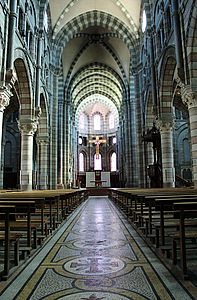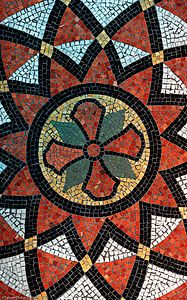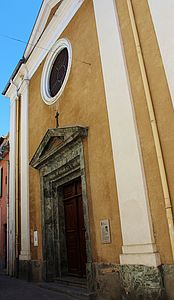Gap's heritage
History in the heart of Gap
Gap, the prefecture of the Hautes-Alpes, nicknamed the "Sweet Capital of the Southern Alps", is located 100 km south of Grenoble and 180 km north of Marseille.
A strategic position in the heart of the mountains!
In the 1st century BC, a garrison of Roman legionaries founded Vapincum - a defensive station located on the Roman road "Via Domitia".
Thanks to its strategic position between Provence and Dauphiné, it became an important trading centre from the Middle Ages.
Religious wars and the burning of the town by the Duke of Savoy in 1692 did not prevent Gap from becoming a crossroads linking Marseille to Grenoble, which became the capital of the Hautes-Alpes in 1790. The roads developed towards Valence (via the Cabre pass) and towards Italy, via the Montgenèvre pass, under the impetus of the prefect Ladoucette appointed in 1802.
Napoleon Bonaparte was to be accommodated there on his return from Elba in 1815. This journey gave rise to the "Route Napoléon" tourist route.
Gap was, in all probability, occupied by the Gallic people of the Avantici. It is likely that they occupied fortified settlements on the hills of Saint-Mens and Puymaure. In the middle of the 1st century BC, the first Roman-type settlements were built on what is now the cathedral square. Gap played the role of mansio (inn relay) on the Per Alpem Cottiam road (the road through the Alps and the kingdom of Cottius) and a crossroads role with other Roman roads. A small village developed and gained in importance. Houses were built as well as places of worship. All these elements are attested by archaeology. In the Late Empire (probably towards the end of the 3rd century), due to its development and its strategic position, Gap became the chief town of a city (an autonomous town which dominates a territory). This new status encouraged the inhabitants to show it by building a rampart and remodelling the urban space. With the spread of Christianity, but even more so when it triumphed by becoming the official religion of the Empire in 392, a bishop settled in Gap and the town welcomed its first cathedral, probably at the end of the 5th or beginning of the 6th century. Due to the vicissitudes of history, there were at least four other cathedrals, the last one being the one we see today, which was completed in 1906.
During the Middle Ages, the town developed under the joint authority of secular lords (the Provençals of Forcalquier or the Dauphins of the Dauphiné) and ecclesiastical lords (bishops, but also the heads of the various religious houses established in the town or in its vicinity). The town hosts a weekly market and several renowned fairs, and many pilgrims pass through (pilgrimage to Embrun, Compostela, Rome...). The town was surrounded by ramparts which were built and maintained by the population and its syndics. The installation of the popes in Avignon in the 14th century reinforced its position as a passageway.
In modern times, the city suffered from the wars of religion during which it was taken and retaken in turn by the Catholic party and the Protestants led by a fiery Champsaurin warlord, the future Constable de Lesdiguières. The cathedral, the episcopal palace and part of the city were destroyed in 1575. In 1692, during the wars of the League of Augsburg, the town was taken and ravaged by a motley crew of troops in the pay of the Duke of Savoy. It was partly rebuilt with funds from the personal coffers of King Louis XIV. After this setback, the town resumed its development and was redesigned on several occasions. In 1790, it became the capital of the Hautes-Alpes department but also a second line garrison town.
In March 1815, on his return from exile on the island of Elba, Napoleon stayed there for a few hours. It is from this ascent of France, from the Juan golf course to Paris, that the beautiful tourist route of the Alps, known as the Napoleon route, was born.
Its role as a road crossroads developed throughout the 18th and 19th centuries, culminating in the arrival of the railway in 1875. The train had a double effect: it emptied the countryside of the Haute-Alpes (rural exodus) while strengthening the attractiveness of Gap.
The town's urban layout retains a part of its history, but both ancient and medieval remains are rare. The numerous urban developments have removed a large part of this history, but there are still a few narrow, winding streets here and there which give it a somewhat medieval appearance.
Source : History-Geography teacher and local history specialist
The present configuration of the city centre corresponds approximately to the general appearance of the medieval city, despite the major urbanistic changes initiated in the 19th century. The structure of the city centre should be understood as a historical continuity. Narrow streets and intertwined lanes, and high housing are the witnesses of the past of a "fortified" city.
Let yourself be charmed by the old centre of Gap, which will be sure to seduce and surprise you.

Monuments in the heart of Gap
Far from being able to make an exhaustive list of the richness of Gap's built heritage, we suggest you discover some ideas of places to visit during your stay in Gap.
Feel free to deepen your discovery with our guided tours!
The Cathedral
The first cathedral church was built on this site (Place Saint Arnoux) in the 5th century on the ruins of a Roman temple dedicated to Apollo.
Over the centuries, several buildings followed one another until the current monument was built between 1867 and 1905 by the architect Charles Laisné. Dedicated to Notre-Dame de l'Assomption, it was classified as a historical monument on August 9, 1906.
The use of stones of various colours from 41 different quarries gives a majestic look to the whole building, where Romanesque and Gothic styles are mixed.
The mosaics of the alley and the choir were made by Gian Domenico Facchina in 1892, who designed the facades of the Opéra Garnier in Paris.
The Chapel of the Penitents
A place of worship that has become a mythical concert hall for its incredible acoustics, the Chapelle of the Penitents has a special atmosphere between history and modernity.
The Town Hall
The first communal house was built in 1400 on the current site of the Town Hall. The construction of the belfry overlooking the building dates back to 1407. Destroyed by the fire caused by the Duke of Savoy's troops in 1692, the building was rebuilt according to the plans of the architect Lechat and finished in 1743, as indicated by the Roman numeral inscription under the balcony. The facade and interior staircase of the Town Hall were included in the additional inventory of Historic Monuments on 29 November 1948.
The coat-of-arms of Gap
Gap's coat-of-arms consists of an azure-coloured shield, surrounded by two golden branches, one of oak and the other of laurel, and surmounted by four crenellated turrets. The latter correspond to the four gates of the 15th century rampart - Colombe, Jaussaude, Lignole and Saint-Arey - which allowed people to enter the city. Inside the shield is the city gate, from which protrude four other turrets, two crenellated and two covered, which correspond mutually to the two governments of the city: the Civil Power and the Ecclesiastical Power.
The choice of colours is also not insignificant - blue for the azure sky of Provence and gold for the sun that had just gilded the city wall.
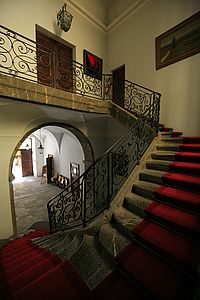
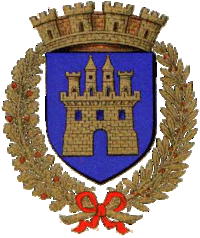
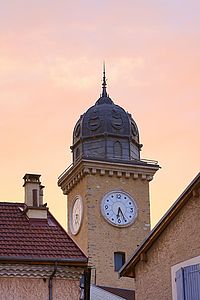
The abandoned village of Chaudun
The village of Chaudun, founded in 1593, was abandoned by its inhabitants at the end of the 19th century. It illustrates the economic difficulties that led to the rural exodus, some "chauduniers" made the choice to emigrate to Algeria, the United States or Canada in search of a better life.
Today the site is in the heart of a vast domain with wild landscapes and at the crossroads of hiking trails. Located between 1300 and 1350 m, this large circular valley, where torrents converge, is surrounded by peaks exceeding 2000 m in altitude such as the Gleize peak. Here reign a varied fauna and flora which enrich this site classified Natura 2000. The mouflon (which counts more than 500 congeners here), the fir forest of the Bois du Chapitre or the pulsatilla anemone are emblematic of this biodiversity.
For children: discover the city differently with Randoland (game in French)
Toutourisme:
The heritage of Gap is accessible with doggies, except the cathedral and the departmental museum.




